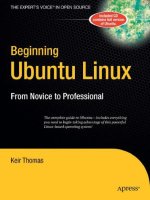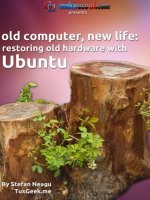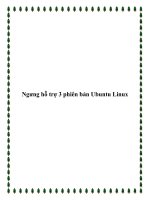Starting with Ubuntu Linux
Bạn đang xem bản rút gọn của tài liệu. Xem và tải ngay bản đầy đủ của tài liệu tại đây (198.71 KB, 16 trang )
Starting with
Ubuntu Linux
Whether you make extensive use of Ubuntu
Linux at work every day, or just putter around
with it once in a while, a book that presents
efficient and comprehensive ways to maintain,
monitor, secure, and enhance Ubuntu can be an
invaluable resource.
Ubuntu Linux Toolbox is that resource.
Ubuntu Linux Toolbox is aimed primarily at power
users and systems administrators. To give you
what you need, we will show you how to quickly
find and install software for Ubuntu, as well as
how to update, maintain, and monitor the health
and security of your system. In short, we will
show you the most efficient ways of using Ubuntu
by working with some of the powerful tools that
are at your fingertips.
The goal of this book is to pack as much useful information as possible
into a small package that you can carry around with you. To that end,
we describe:
❑ Commands — Tons of command line examples demonstrate clever
and useful ways to navigate the often daunting command line.
❑ GUI tools — Quick tips for using graphical interface tools to admin-
ister and configure your Ubuntu system.
❑ Software repositories — Methods for downloading and installing the
software which is custom made for your Ubuntu system.
❑ Online resources — Where to find useful and helpful information
about Ubuntu, such as mailing lists that you can subscribe to, IRC
channels, and other online resources.
❑ Local documentation — Tools for working with the man pages, the
standard Linux and Unix reference volumes, as well as specific docu-
mentation for the software you install.
IN THIS CHAPTER
Introducing
Ubuntu Linux
Finding Ubuntu
resources
Learning quick and
powerful commands
Referencing useful
utilities
Working as Linux
gurus do
82935c01.qxd:Toolbox 10/29/07 12:55 PM Page 1
Because this book is for people already familiar with Linux, there won’t be a lot of
screenshots of icons and menus. What you get instead is the quickest path to using
your Ubuntu system to its fullest extent.
What you learn in this book will help you become more adept at working with your
Ubuntu or Debian system, as well as Linux in general. If this sounds useful to you,
please read on.
Ubuntu, Debian, and Linux
Ubuntu is an operating system based on Debian GNU/Linux (
www.debian.org/
).
Debian has been around since the early 1990s, and because of its maturity, is regarded
as a leading Linux distribution in terms of stability and security. Debian is also known
for its strict adherence to free software (
www.debian.org/intro/free
). It is on this
foundation that Ubuntu has been formed.
If you think of Linux as a cake in a bakery, the Linux kernel and operating system
files would compose the soft spongy cake material itself. Not a whole lot to look at,
but extremely functional as far as cake goes. Linux distributions, in contrast, take
that spongy cake and add top and bottom borders, colors, tiers, side trim, frostings,
flavors, decorations, designs, candles, nuts, and sprinkles. As diverse as cakes are in
a bakery window, so are Linux distributions. Ubuntu, designed by the Canonical
Group (
www.canonical.com/
), is the icing and color of a Linux distribution built
on top of a Debian cake center.
Debian has given rise to not only Ubuntu, but many other Linux distributions
(
www.debian.org/misc/children-distros
):
❑ Xubuntu — An Xfce-based desktop system based on Ubuntu.
❑ Kubuntu — A KDE-based desktop system based on Ubuntu.
❑ Edubuntu — An Ubuntu derivative focused on schools.
❑ Knoppix — A KDE desktop-oriented live CD based on Debian.
❑ Kanotix — A Debian-based live CD.
❑ Damn Small Linux — A tiny (50MB) live CD based on Knoppix.
❑ Mepis — A desktop live CD based on Ubuntu and Debian.
Xubuntu, Kubuntu, and Edubuntu are the same Debian-based Ubuntu distribution
under the hood. The only difference in these is the default desktop they run, or the
collection of applications bundled with them. For example, Kubuntu features the KDE
Desktop and Adept package manager, which are not installed on Ubuntu. Edubuntu
is geared towards educational applications, many of which are not installed by default
on the other *ubuntu distros.
Chapter 1: Starting with Ubuntu Linux
2
82935c01.qxd:Toolbox 10/29/07 12:55 PM Page 2
Because Debian and Ubuntu are open source systems with many parts built on the GNU
General Public License (
www.gnu.org/copyleft/gpl.html
), anyone is free to take the
GPL-based source code, or any part of the GPL’d system, and modify, strip down, build
upon, extend, embed, reverse-engineer, and freely distribute those changes or modifica-
tions. Generally, the only requirement is that you abide by the terms of the GPL, which
basically states that any changes you make to existing GPL works must be made avail-
able for others to utilize in the same way (see
www.debian.org/social_contract
for
other licenses Debian recognizes).
In the end, you have not only a superior system with a free, online, worldwide support
base, but a product which is constantly evolving and driven by people with a passion
for what they do. Many other Linux distributions offer these same advantages; how-
ever, Ubuntu has certainly pulled out in front in terms of popularity.
NOTE Ever wonder where Ubuntu (Edgy Eft) and Debian (Woody) get those
odd naming conventions from? Find out at
/>DevelopmentCodeNames
or
www.debian.org/doc/manuals/project-
history/ch-releases.en.html
.
Ubuntu Compared to
Other Linux Distributions
If you log into the command line of both an Ubuntu system and a Red Hat Enterprise
Linux or Fedora system, very little will look different. There are common directories
and utilities between the two, and functionality is fundamentally the same. So what
makes Ubuntu different from other Linux distributions? One difference is the installer.
The complexity of booting and installing Ubuntu has been narrowed down to a hand-
ful of mouse clicks, making many of the install decisions automatic based on assump-
tions as to what the average user may need and want. In contrast, a Red Hat system
presents the user with many install options, such as setting up a workstation or server,
individually selecting packages to install, and setting administrative options.
Another major difference among Linux distributions is in software management tools.
The aim of the utilities and packaging systems is the same for Debian as for other Linux
distributions, however the operation and implementations are significantly different.
Ubuntu and most other Debian-based systems use the APT (Advanced Package Tool)
family of utilities for managing software. You use APT to install, remove, query, and
update Debian (deb) packages. Red Hat uses an RPM packaging system to handle the
same tasks with its rpm packages.
Another big difference is the way the systems look in regards to initialization, login
screen, default desktop, wallpaper, icon set, and more. From this look-and-feel perspec-
tive, there are a lot of differences. Although Red Hat and Ubuntu both use the GNOME
desktop as the default Window Manager, the GUI tools used for administering the sys-
tem and their locations on the drop-down menus are entirely different.
3
Chapter 1: Starting with Ubuntu Linux
82935c01.qxd:Toolbox 10/29/07 12:55 PM Page 3
The login screen and autumn-colored theme of a default Ubuntu system set it apart
from other distributions as well. When you drop down the menus of an Ubuntu desk-
top, you are not presented with a huge list of applications and utilities. What you get
is a rather simple and elegant mixture of some of the best and most functional appli-
cations available for the Linux desktop. This approach is characteristic of Ubuntu and
is done with the intent of keeping the user from feeling overwhelmed.
Another unique characteristic of a Ubuntu system is the intentional practice of locking
the root user account, and instead implementing the use of
sudo
(
www.gratisoft
.us/sudo/intro.html
), which allows you to run one command with root permis-
sions, for system administration tasks (see Chapter 3 for details on the
sudo
command).
The root login on a Linux system has privileges that allow unrestrained access to nearly
every component of the system. It would be trivial to remove an entire file system as the
root user, so Ubuntu tries to limit use of this account to only times when it is prudent.
Most Linux distributions require the user to log in or su to root to perform administra-
tion tasks, however a user on a Ubuntu does this through
sudo
using their own login
password, and not a separate one for the root user.
Ubuntu has unique features that have their advantages and disadvantages, but they
are far from limiting. Ubuntu has the tools in place to allow you to customize, modify,
experiment, and hack to your heart’s content if that is what you want to do. Otherwise,
the idea is to be an easily maintainable, secure system with a clear and concise applica-
tion set which is neither limiting nor overwhelming. This makes Ubuntu a very fluid
system so you can jump right in and become familiar with it very quickly.
Finding Ubuntu Resources
The Ubuntu community has a vast pool of knowledge you can draw from in the form
of online resources. The following is a list of links to some of the most popular and
useful venues.
❑
— In this searchable web forum and moderated
social network is a diverse, talented, and moderated community of Ubuntu users
and support staff. Here people share their success and setbacks with each other as
well as offering assistance and guidance. Chances are good that if you’re having
difficulty with something in Ubuntu, someone has already run into the same prob-
lem and found a solution.
❑
www.ubuntu.com/support
— This site offers paid support from Canonical Ltd.,
the company behind Ubuntu. If you don’t want to spend time searching through
the forums, or waiting for responses, Canonical Ltd. is one avenue for telephone,
e-mail, and web support costing around $20 a month. There is also Ubuntu train-
ing available aimed at companies and corporate users.
❑
— This site contains the official, up-to-date, online
documentation for each Ubuntu release. As newer Ubuntu releases come out, you
can come here to find out what’s new.
4
Chapter 1: Starting with Ubuntu Linux
82935c01.qxd:Toolbox 10/29/07 12:55 PM Page 4
❑
— View recorded desktop sessions on how
to do different things with Ubuntu, from setting up a printer, to setting up Samba
file sharing, to installing updates to keep your Ubuntu system in top shape. Ubuntu
users are encouraged to join the Ubuntu Screencasts Launchpad Team (
https://
launchpad.net/~ubuntu-screencasts
) to contribute.
❑
/>— Join the
Ubuntu-users mailing list and interact with Ubuntu users over e-mail to discuss
and solve problems that come up with everything from implementing mysql
databases to setting up a problematic network devices. An archive of past threads
can be viewed at
/>.
❑
/>— If you are interested in live
IRC chat support, you can visit the Ubuntu IRC resource page to find guidelines,
clients, and chat servers which are an available source of support, free at any time.
It is advisable to visit the Ubuntu Code of Conduct page (
www.ubuntulinux.org/
community/conduct/
) if you have not taken part in IRC chat before.
If you plan on buying hardware to use with your Ubuntu or other Linux system, these
sites may be helpful in determining where to spend your money:
❑
www.linux-usb.org
— This web site aims to maintain a working knowledge of
USB devices known to be Linux-friendly. There is a search utility where you can
plug in the name or model of a manufacturer and get an instant status report on
the usability of that device with Linux.
❑
www.linux-foundation.org/en/OpenPrinting
— The CUPS (
http://cups
.org
) printing system is the standard printing system used on most Linux systems
these days. If your printer model is not listed when you attempt to add a new
printer to your Ubuntu system, you may need to search this site for an updated
PPD file to add to your CUPS system. Vendors who make Linux-friendly print-
ers can also be found at
www.linux-foundation.org/en/OpenPrinting/
Database/SuggestedPrinters
.
❑
www.sane-project.org
— Scanner Access Now Easy (SANE) is a site devoted
to the topic of document scanning on Linux. If you are looking for a scanner or
multifunction printer, check here to see how well the vendors stack up in terms
of Linux support.
❑
— The Linux Documentation Project is a culmination of Guides,
How-To articles, and FAQS covering everything from how to make coffee with
Linux to setting up QoS and Traffic Control.
Certainly this is not a complete list, but these are good places to look first. You can also
try searching for Linux-related support on a hardware vendor’s web site prior to mak-
ing your purchase. If they intend their hardware to work with Linux, they may have
drivers or instructions available. And don’t forget the wealth of information you can
find by searching for Linux on your favorite search engine.
5
Chapter 1: Starting with Ubuntu Linux
82935c01.qxd:Toolbox 10/29/07 12:55 PM Page 5
Lastly, look for a local Linux User’s Group (LUG) in your area. A LUG is a local com-
munity of people keenly interested in Linux and its implementations. You will find
people with a wide range of experience, from system administrators to casual Linux
users, to distro maintainers, to CEOs of companies. LUGs generally meet on a regular
basis for group discussions and hold presentations to demonstrate ways they’ve found
to implement Linux and other related technology.
Some LUGs sponsor local events like install fests (
/>wiki/Install_fest
) or other Linux advocacy–type events. Chances are good that
if you ask a question at a LUG meeting, someone (but more likely several) will have an
answer. A search engine should help you locate a LUG in your area if you decide to pur-
sue this. Most LUGs have web sites or mailing lists that can be easily found online.
Ubuntu Software
Most Ubuntu software can be found on the Ubuntu package web site (
http://
packages.ubuntu.com
). The standard tools — Synaptic, APT, and Update Manager —
are the most common ways of installing software on your Ubuntu system (Chapter 2
provides details on finding and installing software).
Someday though, you may want to experiment and look for software that is not avail-
able in the Ubuntu packages. Most packages will have an MD5sum or GPG key you
can use to verify that downloaded software hasn’t been tampered with (
www.debian-
administration.org/articles/375
). You can also run into compatibility issues
with non-standard software, making upgrades a difficult task. The key to experiment-
ing with non-standard software is to test it out in ways that do not alter your system.
The following list includes some web sites you can check out to see what other soft-
ware is out there.
WARNING! You should be careful about how you go about mixing the software
on your Ubuntu system with software from non-Ubuntu sources. We advise you
to check carefully the authenticity of anything you download.
❑
www.happypenguin.org
— The Linux Game Tome. A collection of games, games,
and more games for Linux, varying from experimental demos to commercial game
companies that have provided source code or binaries to run their games under
Linux. (Thanks, commercial game companies!)
❑
www.freshmeat.net
— Boasts the Web’s largest collection of Unix and cross-
platform software, themes, eye-candy, and Palm-OS software. It also sports a
discussion board for each software entry to facilitate discussions and feedback.
These guys have been around for a very long time.
❑
— When open source developers get together to
start a new project, many go to SourceForge to get their project hosted there.
SourceForge offers web space as well as tools for managing projects, resources,
communications, and code. If you are looking for software, certainly try some
searching here.
6
Chapter 1: Starting with Ubuntu Linux
82935c01.qxd:Toolbox 10/29/07 12:55 PM Page 6









